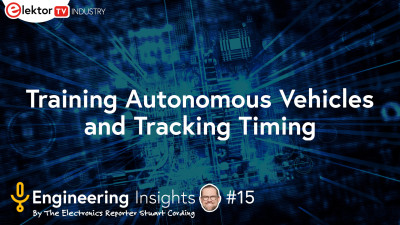Engineering Insights: Sourcing Components and More!
March 21, 2023
on
on
I have been busy exploring the world of component sourcing, getting expert insights into how they find hard-to-source components and check their quality. I have also explored the challenges of bringing new semiconductor packaging to market.
I spoke to Krishna Ganason and Max Gates of Fusion Worldwide in a recent Engineering Insights episode to learn their approach. They work closely with qualified vendors, such as those in the electronics manufacturing services (EMS) industry, taking excess stock before testing it and selling it on to companies that need it.
 Of course, the parts aren't just repacked and shipped on. Each device undergoes rigorous tests to ensure they are genuine, some of which are destructive. This ranges from visual inspection and x-ray to electrical testing. This mitigates the risk to customers, unlike purchasing devices from brokers on the open market. The team also works closely with the semiconductor industry to ensure quality when needed.
Of course, the parts aren't just repacked and shipped on. Each device undergoes rigorous tests to ensure they are genuine, some of which are destructive. This ranges from visual inspection and x-ray to electrical testing. This mitigates the risk to customers, unlike purchasing devices from brokers on the open market. The team also works closely with the semiconductor industry to ensure quality when needed.
And their portfolio isn't limited to semiconductors, extending to cover passive components, memory storage, electromechanical devices, and PC cards.
Nepxeria launched the LFPAK twenty years ago, enabling yet another reduction in board size. This is critical in power applications that are looking to get smaller, lighter, and improve power density for applications such as e-scooters and other forms of electro-mobility or robotics. Some key results are the drop in RDS(on), which has fallen to just 0.67 mΩ, and a rise in IDmax, driving loads of up to 380 A. Since its introduction, it has grown to seven variants and supports over 400 products.
One of the key innovations was the introduction of the copper clip, sandwiching the power semiconductor between two pieces of the metal. This ensures excellent heat dissipation as well as lower parasitics as current flows through the construction. Adding gullwing pins also helped ensure its success, providing mechanical movement as the PCB and package expand and contract. But, initially, many were reticent to take a chance on this new design. Chris Boyce also shared some of the tactics used to convince skeptical engineering audiences to adopt the package.
I also had a Micro:bit Tinker Kit to give to one lucky winner and announced that Roman had won the T01104 Tablet Oscilloscope in the previous episode.
To catch up on the entire episode, jump over to Elektor TV - Industry or watch below:
In Elektor's recent Engineering Insights episode, Giancarlo Cutrignelli of Eurotech explained the process and the hardware required. Test vehicles are used to gather real road conditions as seen by the array of sensors in use, with teams out on the highway for up to eight hours at a time. With up to 40 cameras and four to six radar, data is collected at a rate of around 40 Gbits/s, enough to fill 128 TB of storage in 12 hours. To support this, Eurotech offers a range of ruggedized high-performance edge computing (HPEC). With high-speed Ethernet interface, solid-state storage, and powerful CPU and GPU options, data is gathered reliably in the field and can be speedily transferred to lab-based teams.

Sometimes, deep learning algorithms are tested in the field too, a process known as inferencing. Trained algorithms run on the HPEC in real-time, analyzing the traffic situation and proposing relevant driving responses. This process is not in control of the vehicle; it merely serves to test the algorithm's ability to operate under realistic conditions.
Show host Stuart Cording also had a tablet oscilloscope to give to one lucky winner and announced that Sjon had won the Fortissimo-100 amplifier in the previous episode.
To catch up on the entire episode, jump over to Elektor TV - Industry or watch below:

Sourcing hard-to-find components and creating new packages
The last two years have made component sourcing exceptionally challenging. But this isn't a new problem. There are regular issues sourcing components, especially as they go "end of life" or, due to some regional supply chain issue, supply is disrupted. So, what options are open to design teams in such cases?I spoke to Krishna Ganason and Max Gates of Fusion Worldwide in a recent Engineering Insights episode to learn their approach. They work closely with qualified vendors, such as those in the electronics manufacturing services (EMS) industry, taking excess stock before testing it and selling it on to companies that need it.
 Of course, the parts aren't just repacked and shipped on. Each device undergoes rigorous tests to ensure they are genuine, some of which are destructive. This ranges from visual inspection and x-ray to electrical testing. This mitigates the risk to customers, unlike purchasing devices from brokers on the open market. The team also works closely with the semiconductor industry to ensure quality when needed.
Of course, the parts aren't just repacked and shipped on. Each device undergoes rigorous tests to ensure they are genuine, some of which are destructive. This ranges from visual inspection and x-ray to electrical testing. This mitigates the risk to customers, unlike purchasing devices from brokers on the open market. The team also works closely with the semiconductor industry to ensure quality when needed. And their portfolio isn't limited to semiconductors, extending to cover passive components, memory storage, electromechanical devices, and PC cards.
Launching new packaging
Much focus is given to the semiconductor in the semiconductor industry, but without packaging, they are challenging to integrate with a circuit board. Packaging also plays an important role in the device's operational characteristics. For example, in power devices, it impacts many parasitic parameters and determines its thermal capabilities.Nepxeria launched the LFPAK twenty years ago, enabling yet another reduction in board size. This is critical in power applications that are looking to get smaller, lighter, and improve power density for applications such as e-scooters and other forms of electro-mobility or robotics. Some key results are the drop in RDS(on), which has fallen to just 0.67 mΩ, and a rise in IDmax, driving loads of up to 380 A. Since its introduction, it has grown to seven variants and supports over 400 products.
One of the key innovations was the introduction of the copper clip, sandwiching the power semiconductor between two pieces of the metal. This ensures excellent heat dissipation as well as lower parasitics as current flows through the construction. Adding gullwing pins also helped ensure its success, providing mechanical movement as the PCB and package expand and contract. But, initially, many were reticent to take a chance on this new design. Chris Boyce also shared some of the tactics used to convince skeptical engineering audiences to adopt the package.
I also had a Micro:bit Tinker Kit to give to one lucky winner and announced that Roman had won the T01104 Tablet Oscilloscope in the previous episode.
To catch up on the entire episode, jump over to Elektor TV - Industry or watch below:
Previously, on Engineering Insights:
You've probably seen test cars driving around your town, filled to the brim with cameras, radar, lidar, and computing equipment. They're all part of the automotive industry's push to deliver the long-promised fleet of autonomous cars. But how are they contributing to the necessary deep-learning algorithms? And will the current way of developing automotive electronics fall by the wayside as a result?In Elektor's recent Engineering Insights episode, Giancarlo Cutrignelli of Eurotech explained the process and the hardware required. Test vehicles are used to gather real road conditions as seen by the array of sensors in use, with teams out on the highway for up to eight hours at a time. With up to 40 cameras and four to six radar, data is collected at a rate of around 40 Gbits/s, enough to fill 128 TB of storage in 12 hours. To support this, Eurotech offers a range of ruggedized high-performance edge computing (HPEC). With high-speed Ethernet interface, solid-state storage, and powerful CPU and GPU options, data is gathered reliably in the field and can be speedily transferred to lab-based teams.

Sometimes, deep learning algorithms are tested in the field too, a process known as inferencing. Trained algorithms run on the HPEC in real-time, analyzing the traffic situation and proposing relevant driving responses. This process is not in control of the vehicle; it merely serves to test the algorithm's ability to operate under realistic conditions.
Timing remains relevant
How the electronic and electrical (E/E) architecture is implemented will also need to change. Otherwise, the sensor data collection and necessary autonomous control will be challenging to implement. But, according to Peter Gliwa of Gliwa Embedded Systems, automotive development teams continue to struggle with timing issues. While software teams test to ensure features function correctly, sporadic issues often occur that are difficult to pin down. These are often traced to timing problems, and are typically related to the order in which code is executed and their relationship to other code and occurrences of interrupts. Peter's team support automotive manufacturers and their suppliers to find and resolve such issues. In his recently released book, he also combines his decades of experience with industry experts to help other avoid such challenges.Espressif for AIoT applications
The show's sponsor, Espressif, highlighted their range of AIoT SoCs, featuring Wi-Fi and Bluetooth 5 (LE). The ESP32-C3, based on the open-source RISC-V architecture, strikes the right balance of power, I/O capabilities, and security, thus offering the optimal cost-effective solution for connected devices. For powerful AI acceleration, developers should consider the ESP32-S3. With the same wireless features, it’s designed for AIoT applications thanks to its powerful AI acceleration and reliable security features. It also has added support for vector instructions in the MCU, speeding up neural network computing and signal processing workloads.Show host Stuart Cording also had a tablet oscilloscope to give to one lucky winner and announced that Sjon had won the Fortissimo-100 amplifier in the previous episode.
To catch up on the entire episode, jump over to Elektor TV - Industry or watch below:

Hey - I have a great story...
Great! We'd love to hear it. Feel free to get in touch to learn how to share your news with us. Whether a product launch, new technology, breakthrough, or event, we'll try to squeeze it in somewhere. Simply get in touch with Stuart Cording via email, on Twitter, or LinkedIn.Read full article
Hide full article



Discussion (0 comments)